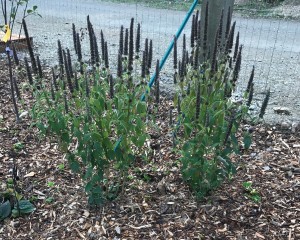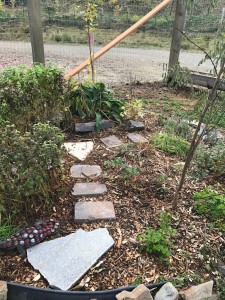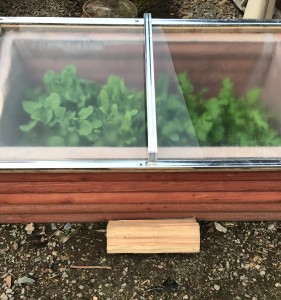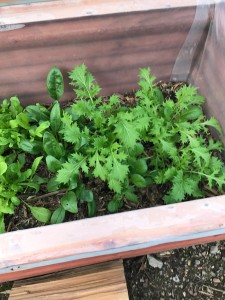This is a beautiful time of year – leaves falling to the ground in colors of orange, red, and yellow. Birds and other little critters running around doing their last minute preparations for winter, and life begins to slow down just a little. One of the main activities we’ve been engaged in on the homestead is getting our gardens ready for winter, and prepped for an even more productive spring. One thing to keep in mind when prepping your gardens for winter and spring – it’s all about your soil. Keep these in mind:
- Feed your soil, not your plants. Fertilizer tea and other natural fertilizers work best since they act slower and amend the soil rather than just feed a particular plant.
- Increase your organic matter through the use of compost (decayed remains and waste products of animals and plants) to increase the availability of the minerals in the soil and create more spaces for air and water.
We have three primary gardens and frankly our soil is not so great in two of them. We have made big efforts the last couple of years to increase soil fertility in our food forest and, with the addition of our herb garden this year, we’ve made the same efforts. Like anything natural, amending soil takes time, this is not an overnight fix. Here are our three primary gardens:
- East Garden – our perennial and annual garden which houses fruit and nut trees, berry bushes, strawberries, and this year, potatoes, tomatoes, peppers, corn, carrots, and lettuce.
- West Garden – our culinary and medicinal herb garden. We are growing a few trees, some bushes, a selection of spring flowers, as well as many perennial herbs (and self-sowing annuals) – chamomile, echinacea, russian sage, lavender, parsley, cilantro, mint, lemon balm, catnip, yarrow, comfrey, and more.
- Food Forest which is pretty self-explanatory – we are growing many fruit and nut trees, bushes, support species, and, since we are cooperating with succession, some annuals like garlic and flowers to attract pollinators
Remember, our focus was soil, we wanted to do something to increase “life” in our soil, we did this through the use of materials we had on the homestead. We are always looking to create “closed systems” which basically means we aim to use natural and sustainable resources we have on hand instead of bringing products in. We have podcasted and talked about the types of fertilizers we use on our homestead:
- Comfrey Fertilizer Tea
- Rabbit Manure
- Rabbit Manure Tea
- Compost from the deep bedding removed from the chicken coop last winter
These are the fertilizers we poured and added to each of our gardens to help improve the biological activity in the soil.
In the Herb garden I was dealing with soil that had very little biological activity and organic matter so our big goal was to increase the organic matter. This spring we had planted a lot of red and white dutch clover which was growing beautifully. Instead of plowing the “green mulch” into the soil I decided to pour our fertilizer tea on top, drop some extra rabbit manure around each plant and top it with 3-4″ of wood chips.
This will help the clover break down and become part of the soil composition. I also planted several different bulbs for spring flowering. We are excited to see what spring will bring in the area of soil fertility in the herb garden.
In the East Garden we decided to leave the roots of all the plants in place. Chopping the corn stalks gave me great material for decorating my front porch which was an added bonus! After cutting down all the plants we covered the garden beds with some compost from the chicken coop and a couple of inches of wood chips. This garden is the area with the best soil since it had been used as a garden by the previous owner, so it requires less inputs from us at this point.
The Food Forest is becoming much more productive. We just finished our second summer with the trees in place and have done our best to utilize the space available right now for annual plantings until the trees canopy out those spots. In August we spent some time “solarizing” two sections of the food forest with the intention of killing the grass and weeds allowing for us to grow some annuals. Though it’s a bit of an experiment we took one of those sides and turned it into a pretty big garlic bed (you can never have enough garlic!) the other side we fertilized and covered in wood chips to prep a little more for spring planting. We spot covered areas with the chicken coop compost, poured rabbit manure tea and placed wood chips around the trees and bushes being careful to leave a little space around the trunks.
View our gardens and food forest on YouTube
With winter coming our outdoor growing season is quickly winding down, but this year we decided to extend our growing season just a little bit by utilizing two cold frames in which we are growing arugula, spinach, kale, chard, and a lettuce mix. It’s wonderful walking out our garage and clipping some fresh greens. We anticipate having these available for at least another 6 weeks or more.
Obviously winter does not allow for much outdoor gardening, however Sean plans on staying very busy growing plants indoors. We expanded our indoor propogation facility by adding 3 additional large sized grow lights. Our plan is to propagate many trees, bushes, and herbs this winter for planting next spring.
Winter can be tough for an anxious gardener to endure, it also serves as a reminder for us to slow down and enjoy the beauty of God’s creation. Many times our spring/summer/early fall are so busy we don’t sit and relax. Winter is that natural break, allowing us to rest (and plan next year’s gardens!)
What are you doing on your homestead to prepare for the coming winter?








Leave a Reply
You must be logged in to post a comment.